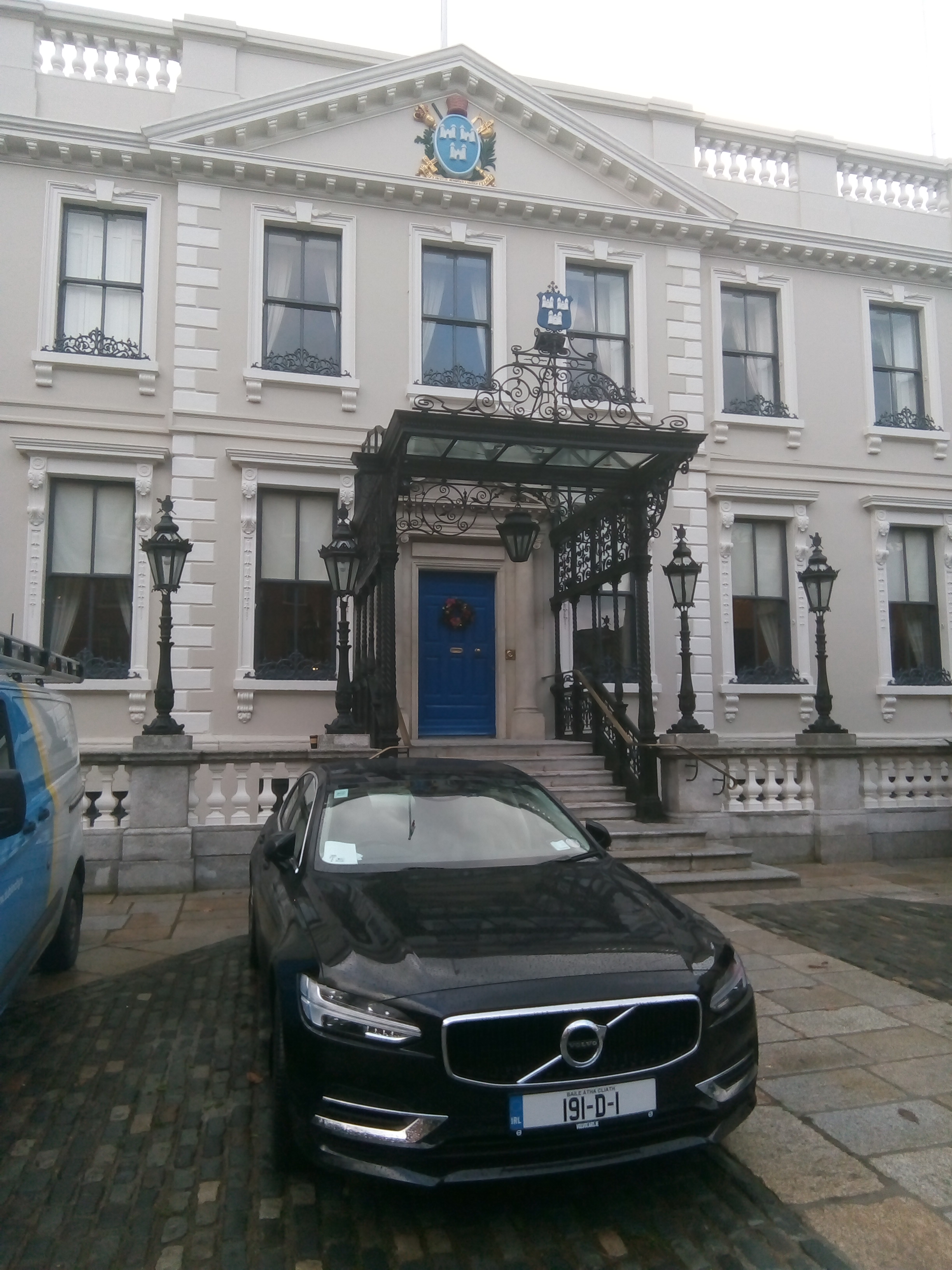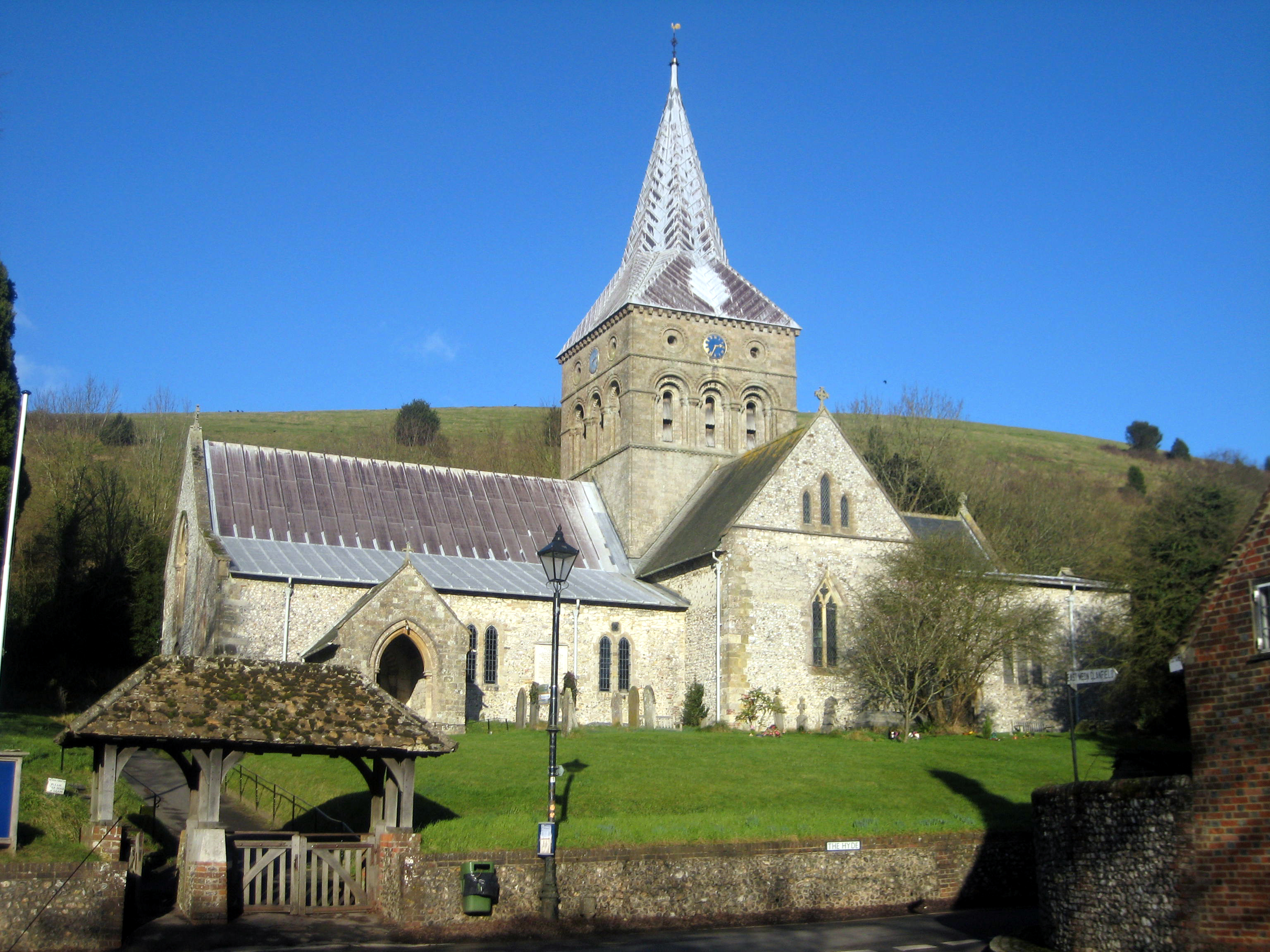|
John Le Decer
John Le Decer (died 1332) was a fourteenth-century Mayor of Dublin, who had a notable record of charitable works and civic improvement. Since the surname is not a common one, it is possible that Robert le Decer, Sheriff of Dublin City in 1280, was a relative of John. John Le Decer served as mayor on six occasions, in 1302, 1305, from 1307 to 1309 and in 1324. He was a man of considerable wealth, and carried out a number of noted public works "at his own expense". His most striking project was the marble cistern he built in 1308. This held Dublin's main water conduit in Cornmarket, adjacent to St. Audoen's Church in the centre of the medieval city, a work "such as was never seen here before". It was commonly called "Le Decer's Fountain", and is so described on the 1400 map of St. Audoen's Church and parish. He set up Dublin's so-called "Lucky Stone" (a ninth-century grave marker) there, reputedly so that everyone who drank from the cistern should have good luck; it had previo ... [...More Info...] [...Related Items...] OR: [Wikipedia] [Google] [Baidu] |
Mayor Of Dublin
The Lord Mayor of Dublin ( ga, Ardmhéara Bhaile Átha Cliath) is the honorary title of the chairperson ( ga, Cathaoirleach, links=no ) of Dublin City Council which is the local government body for the city of Dublin, the capital of Ireland. The incumbent, since June 2022, is councillor Caroline Conroy. The office holder is elected annually by the members of the Council. Background The office of Mayor of Dublin was created in June 1229 by Henry III. The office of ''Mayor'' was elevated to '' Lord Mayor'' in 1665 by Charles II, and as part of this process received the honorific The Right Honourable (''The Rt Hon.''). Lord mayors were ''ex-officio'' members of the Privy Council of Ireland, which also entitled them to be addressed as The Right Honourable. Though the Privy Council was ''de facto'' abolished in 1922, the Lord Mayor continued to be entitled to be addressed as The Right Honourable as a result of the Municipal Corporations (Ireland) Act 1840, which granted the title ... [...More Info...] [...Related Items...] OR: [Wikipedia] [Google] [Baidu] |
Great Famine Of 1315–1317
The Great Famine of 1315–1317 (occasionally dated 1315–1322) was the first of a series of large-scale crises that struck Europe early in the 14th century. Most of Europe (extending east to Russia and south to Italy) was affected. The famine caused many deaths over an extended number of years and marked a clear end to the period of growth and prosperity from the 11th to the 13th centuries. The Great Famine started with bad weather in spring 1315. Crop failures lasted through 1316 until the summer harvest in 1317, and Europe did not fully recover until 1322. Crop failures were not the only problem; cattle disease caused sheep and cattle numbers to fall as much as 80%. The period was marked by extreme levels of crime, disease, mass death, and even cannibalism and infanticide. The crisis had consequences for the Church, state, European society, and for future calamities to follow in the 14th century. Background Famines were familiar occurrences in medieval Europe. For exampl ... [...More Info...] [...Related Items...] OR: [Wikipedia] [Google] [Baidu] |
Lord Mayors Of Dublin
The Lord Mayor of Dublin ( ga, Ardmhéara Bhaile Átha Cliath) is the honorary title of the chairperson ( ga, Cathaoirleach, links=no ) of Dublin City Council which is the local government body for the city of Dublin, the capital of Ireland. The incumbent, since June 2022, is councillor Caroline Conroy. The office holder is elected annually by the members of the Council. Background The office of Mayor of Dublin was created in June 1229 by Henry III. The office of ''Mayor'' was elevated to '' Lord Mayor'' in 1665 by Charles II, and as part of this process received the honorific The Right Honourable (''The Rt Hon.''). Lord mayors were ''ex-officio'' members of the Privy Council of Ireland, which also entitled them to be addressed as The Right Honourable. Though the Privy Council was ''de facto'' abolished in 1922, the Lord Mayor continued to be entitled to be addressed as The Right Honourable as a result of the Municipal Corporations (Ireland) Act 1840, which granted the titl ... [...More Info...] [...Related Items...] OR: [Wikipedia] [Google] [Baidu] |
Rathmines
Rathmines () is an affluent inner suburb on the Southside of Dublin in Ireland. It lies three kilometres south of the city centre. It begins at the southern side of the Grand Canal and stretches along the Rathmines Road as far as Rathgar to the south, Ranelagh to the east, and Harold's Cross to the west. It is situated in the city's D06 postal district. Rathmines is a commercial and social hub and is well known across Ireland as "flatland"—an area that has provided rented accommodation to newly arrived junior civil servants and third-level students from outside the city since the 1930s. In more recent times, Rathmines has diversified its housing stock and many houses have been gentrified. Rathmines gained a reputation as a "Dublin Belgravia" in the 19th Century. Name Rathmines is an Anglicisation of the Irish , meaning "ringfort of Maonas"/"fort of Maonas". The name Maonas is perhaps derived from Maoghnes or the Norman name de Meones, after the de Meones family who settled ... [...More Info...] [...Related Items...] OR: [Wikipedia] [Google] [Baidu] |
De Meones Family
The De Meones, or de Moenes family were an Anglo-Irish family who originated at East Meon in Hampshire. They moved to Ireland in the late thirteenth century, became substantial landowners in Dublin and Meath, and gave their name to the suburb of Rathmines. Foundations The family originally came from the village of East Meon in Hampshire. William de Meones, the first family member of note to live in Ireland, came from England in 1279–80 as a clerk in the entourage of John de Derlington, Archbishop of Dublin.Ball, F. Elrington ''The Judges in Ireland 1221–1921'' John Murray London 1926 Vol.1 pp.58, 88 He acted as the Archbishop's executor following his death in 1284, and in that capacity he defended a lawsuit brought by Thomas de Chaddesworth, Dean of St Patrick's Cathedral, for expenses allegedly due to him.Monck, William Mason "''The History and Antiquities of the Collegiate and Cathedral Church of St Patrick near Dublin"'' Dublin 1820 p.113 He became Chief Baron of the Ir ... [...More Info...] [...Related Items...] OR: [Wikipedia] [Google] [Baidu] |
Anglo-Irish
Anglo-Irish people () denotes an ethnic, social and religious grouping who are mostly the descendants and successors of the English Protestant Ascendancy in Ireland. They mostly belong to the Anglican Church of Ireland, which was the established church of Ireland until 1871, or to a lesser extent one of the English dissenting churches, such as the Methodist church, though some were Roman Catholics. They often defined themselves as simply "British", and less frequently "Anglo-Irish", "Irish" or "English". Many became eminent as administrators in the British Empire and as senior army and naval officers since Kingdom of England and Great Britain were in a real union with the Kingdom of Ireland until 1800, before politically uniting into the United Kingdom of Great Britain and Ireland) for over a century. The term is not usually applied to Presbyterians in the province of Ulster, whose ancestry is mostly Lowland Scottish, rather than English or Irish, and who are sometimes id ... [...More Info...] [...Related Items...] OR: [Wikipedia] [Google] [Baidu] |
Franciscan
The Franciscans are a group of related Mendicant orders, mendicant Christianity, Christian Catholic religious order, religious orders within the Catholic Church. Founded in 1209 by Italian Catholic friar Francis of Assisi, these orders include three independent orders for men (the Order of Friars Minor being the largest contemporary male order), orders for women religious such as the Order of Saint Clare, and the Third Order of Saint Francis open to male and female members. They adhere to the teachings and spiritual disciplines of the founder and of his main associates and followers, such as Clare of Assisi, Anthony of Padua, and Elizabeth of Hungary. Several smaller Franciscan spirituality in Protestantism, Protestant Franciscan orders exist as well, notably in the Anglican and Lutheran traditions (e.g. the Community of Francis and Clare). Francis began preaching around 1207 and traveled to Rome to seek approval from Pope Innocent III in 1209 to form a new religious order. The o ... [...More Info...] [...Related Items...] OR: [Wikipedia] [Google] [Baidu] |
Monastery
A monastery is a building or complex of buildings comprising the domestic quarters and workplaces of monastics, monks or nuns, whether living in communities or alone (hermits). A monastery generally includes a place reserved for prayer which may be a chapel, church, or temple, and may also serve as an oratory, or in the case of communities anything from a single building housing only one senior and two or three junior monks or nuns, to vast complexes and estates housing tens or hundreds. A monastery complex typically comprises a number of buildings which include a church, dormitory, cloister, refectory, library, balneary and infirmary, and outlying granges. Depending on the location, the monastic order and the occupation of its inhabitants, the complex may also include a wide range of buildings that facilitate self-sufficiency and service to the community. These may include a hospice, a school, and a range of agricultural and manufacturing buildings such as a barn, a fo ... [...More Info...] [...Related Items...] OR: [Wikipedia] [Google] [Baidu] |


.jpg)
.jpg)



